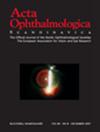Flicker modulation sensitivity with dual-focus contact lenses for myopia control
Abstract
Aims/Purpose: Myopic children are increasingly prescribed soft multifocal contact lenses to slow the progression of myopia. Their impact on central and peripheral vision is not fully understood beyond visual acuity, a measurement that is not sensitive enough to detect small changes in visual performance caused by increased higher-order aberrations and scattered light. The aim of this study was to investigate up to what extent Dual-focus (DF) contact lenses, designed for myopia control, affect flicker modulation sensitivity (FMS) measured in central vision and near periphery across photopic and mesopic light levels.
Methods: Right eyes of twenty-five myopic and non-presbyopic young adults were fitted with two soft contact lens designs, a DF with addition power of +2.00 D located in the near periphery and a single-vision (SV) contact lens of the same material and parameters, in random order. 30 minutes after contact lens insertion, photopic and mesopic FMS were measured foveally (0 degrees) and at four near peripheral locations selected diagonally away from fixation at an eccentricity of 5 degrees in each of the four quadrants to produce a measure of overall peripheral FMS.
Results: The mean visual acuity did not vary significantly between the DF and SV contact lenses. Mean central fovea FMS were 0.12 log units worse in the DF than the SV contact lens, under both photopic (p < 0.001) and mesopic (p = 0.001) luminance conditions. Mean peripheral FMS were 0.04 log units worse with the DF contact lens than SV contact lens, under both photopic (p = 0.002) and mesopic (p = 0.048) light levels.
Conclusions: DF contact lenses designed for myopia control reduced FMS compared to SV contact lenses, with the reduction being greater for central fovea FMS than for near periphery FMS, for both photopic and mesopic luminance conditions. The blurred background noise created by the peripheral power of DF contact lenses is likely to influence both central and peripheral vision.

 求助内容:
求助内容: 应助结果提醒方式:
应助结果提醒方式:


